M109 howitzer
The M109 is an American 155 mm turreted self-propelled howitzer, first introduced in the early 1960s to replace the M44. It has been upgraded a number of times, most recently to the M109A7. The M109 family is the most common Western indirect-fire support weapon of maneuver brigades of armored and mechanized infantry divisions.
| M109 Howitzer | |
|---|---|
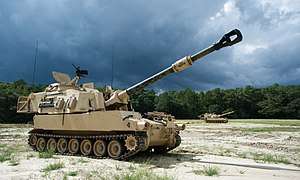 M109A6 | |
| Type | Self-propelled gun |
| Place of origin | United States |
| Service history | |
| In service | (M109) 1963–present (M109A7) 2013–present |
| Wars | Vietnam War Cambodian Civil War Yom Kippur War Iran–Iraq War Western Sahara War Persian Gulf War Iraq War 2014 Israel–Gaza conflict Iraqi Civil War (2014–2017)[1] Yemeni Civil War (2015–present), Saudi Arabian-led intervention in Yemen Syrian Civil War |
| Specifications | |
| Mass | 27.5 tons |
| Length | 30 ft (9.1 m) |
| Width | 10 ft 4 in (3.15 m) |
| Height | 10 ft 8 in (3.25 m) |
| Crew | 7 (2 Ammunition Handlers, Gunner, 2 Loaders, Commander, Driver) |
| Shell | separate loading, bagged charge |
| Caliber | 155 mm L/39 caliber[2] |
| Breech | interrupted screw |
| Traverse | 360° |
| Rate of fire | Maximum: 4 rpm/3 min.[3] Sustained: 1 rpm[3] |
| Effective firing range | Conventional: 21 km (13 mi) RAP: 30 km (19 mi) |
Main armament | M126 155 mm Howitzer |
Secondary armament | .50 caliber (12.7 mm) M2 machine gun |
| Engine | Detroit Diesel 8V71T 450 hp (335.56 kW) |
| Power/weight | 18.7 hp/t |
| Suspension | torsion-bar |
Operational range | 216 mi (350 km) |
| Maximum speed | 35 mph (56 km/h) |
The M109 has a crew of four: the section chief/commander, the driver, the gunner, and the ammunition handler/loader. The chief or gunner aims the cannon left or right (deflection) and up and down (quadrant).
The British Army replaced its M109s with the AS-90. Several European armed forces have or are currently replacing older M109s with the German PzH 2000. Upgrades to the M109 were introduced by the U.S. (see variants below) and by Switzerland (KAWEST). With the cancellation of the U.S. Crusader and Non-Line-of-Sight Cannon, the M109A6 ("Paladin") will remain the principal self-propelled howitzer for the U.S. for the foreseeable future until the new M1299 will enter service.
History

The M109 was the medium variant of a U.S. program to adopt a common chassis for its self-propelled artillery units. The light version, the M108 Howitzer, was phased out during the Vietnam War, but many were rebuilt as M109s.
The M109 saw its combat debut in Vietnam. Israel used the M109 against Egypt in the 1973 Yom Kippur War and in the 1982 and 2006 Lebanon Wars. Iran used the M109 in the Iran–Iraq War in the 1980s. The M109 saw service with the British, Egyptian and Saudi Arabian Armies in the 1991 Gulf War. The M109 also saw service with the U.S. Army in the Gulf War, as well as in the Iraq War from 2003–2011.
Upgrades to the cannon, ammunition, fire control, survivability, and other electronics systems over the design's lifespan have expanded the system's capabilities, including tactical nuclear projectiles, Cannon Launched Guided Projectiles (CLGP or Copperhead), Rocket Assisted Projectile (RAP), FAmily of SCAtterable Mines (FASCAM), and improved conventional munitions (the Dual-Purpose Improved Conventional Munition, DPICM).
Design
The M109 was developed by the Ground System Division of United Defense LP (now BAE Systems Land and Armaments).[2]
Armament
- Primary: M126 (or M126A1) 155 mm Howitzer (M109), M185 155 mm Howitzer (A1/A2/A3/A4), M284 155 mm Howitzer (A5/A6)
- Secondary: .50 caliber (12.7 mm) M2 machine gun, Mk 19 Mod 3 40 mm Automatic Grenade Launcher, or 7.62 mm M60, M240 machine gun or the British L4 machine gun
Hypervelocity Projectile (HVP)
In January 2016, the U.S. Army test-fired hypervelocity projectiles originally designed for use by U.S. Navy electromagnetic railguns and found that they significantly increased the gun's range. The Army is looking into using the M109 Paladin firing the HVP for ballistic missile defense, as traditional missile interceptors are expensive and gun-based missile defense used for point defense would use artillery at a much lower cost per round.[4][5] The HVP is capable of being fired out to 50 nautical miles (58 mi; 93 km) from a conventional cannon. It weighs 68 lb (31 kg) with a 46 lb (21 kg) flight body containing its guidance and warhead—less powerful, but more agile to hit small, high-speed targets. Modifications will be needed for the Paladin to effectively shoot the HVP, possibly including different propellant to achieve higher velocities, automated reloading systems to fire quickly enough to defeat salvo launches, improved barrel life, and a new fire control and sensor system.[6]
Variants
M109
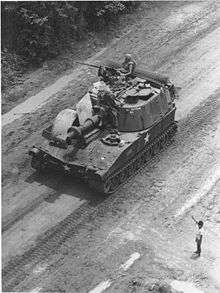
First produced in 1963. It had a 23 caliber 155 mm M126 gun in an M127 Howitzer Mount, and carried 28 rounds of 155 mm ammunition. It was also armed with a .50cal M2HB machine gun with 500 rounds of ammunition. Easily identified by its short barrel and a double baffle muzzle brake with a large fume extractor just behind it. Maximum range of 14,600 meters.
M109A1
Replaced the M126 gun with a longer barreled, 39 caliber M185 gun, increasing maximum range to 18,100 meters.
M109A2
Incorporated 27 Reliability, Availability, and Maintainability (RAM) mid-life improvements. Most notably, the long barreled 155 mm M185 cannon in the new M178 gun mount, ballistic protection for the panoramic telescope, counterbalanced travel lock, and the ability to mount the M140 alignment device. Stowage of 155mm rounds increased from 28 to 36 rounds; .50cal ammunition remained at 500 rounds. During M109A2 production, a slightly simplified version was also produced for export. This had minor internal changes and deleted the hull flotation feature. These were designated M109A1B.[7]
M109A3 and M109A3B
M109A1s and M109A1Bs rebuilt to M109A2 standard respectively. Some A3s feature three contact arm assemblies, while all A2s have five.
M109A4
M109A2s and M109A3s improved with Nuclear, Biological, and Chemical / Reliability, Availability, and Maintainability (NBC/RAM) improvements, including air purifiers, heaters, and Mission Oriented Protective Posture (MOPP) gear.
The traversing mechanism's clutch is hydraulic, as compared to the electric mechanism on previous M109s, and features a manual override in the event of an electrical failure. The A4 also adds an additional hydraulic filter, for a total of two. Also included is an improvement to the engine starting equipment, greatly improving the ability to start in an emergency.
Ammunition amounts remain the same as two previous models.
M109A5
Replaces the 155 mm M185 cannon in an M178 mount with a 39-caliber 155 mm M284 cannon in an M182 mount, giving the A5 a maximum range of 22,000 meters with unassisted projectiles and 30,000 meters with Rocket Assisted Projectiles (RAP Rounds).[8] The vehicle can carry 36 complete rounds of ammunition and has a 440 hp engine instead of the standard 405 hp engine.
M109A5+
Various manufacturers have upgraded the fire control and other components of the M109A5. BAE Systems in York PA recently delivered 12 M109A5+ vehicles to Chile and 32 for Brazil.
M109A6 "Paladin"
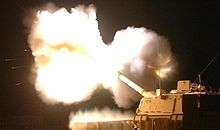
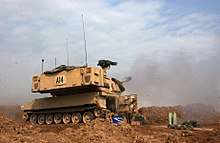
Overall product improvement in the areas of survivability, RAM, and armament. This includes increased armor, a redesigned internal arrangement for safer ammunition and equipment storage, engine and suspension upgrades, and product improvement of the M284 cannon and M182A1 mount. The greatest difference is the integration of an inertial navigation system, sensors detecting the weapons' lay, automation, and an encrypted digital communication system, which utilizes computer controlled frequency hopping to avoid enemy electronic warfare and allow the howitzer to send grid location and altitude to the battery fire direction center (FDC). The battery FDCs in turn coordinate fires through a battalion or higher FDC. This allows the Palladin to halt from the move and fire within 30 seconds with an accuracy equivalent to the previous models when properly emplaced, laid, and safed—a process that required several minutes under the best of circumstances. Tactically, this improves the system's survivability by allowing the battery to operate dispersed by pairs across the countryside and allowing the howitzer to quickly displace between salvos, or if attacked by indirect fire, aircraft, or ground forces.
Ammunition storage is increased from 36 to 39 155 mm rounds.
M109 "KAWEST"
This Swiss improved version produced by Ruag incorporates a new Swiss-designed L47 155 mm gun with an increased firing range of up to 36 km. It features inertial navigation system coupled with a new gun-laying system and more ammunition storage(40 rounds, 64 charges). The KAWEST (lit. Kampfwertsteigerung = upgrade of combat capabilities) requires only 6 crew members instead of 8, and is able to fire 3-round bursts within 15 seconds or maintain a constant firing rate of over one round per minute.[9][10]
Upgraded Swiss PzHb (Panzerhaubitze) 79 and 88 (M109A1) are known as respectively PzHb 79/95 and PzHb 88/95.
M109L52
Jointly developed by the Dutch firm RDM and the German firm Rheinmetall, the M109L52 was first revealed in 2002. The main improvement was replacing the M126 series gun with the longer 52-caliber cannon from the PzH 2000, thus the MTLS ammunition of the PzH 2000 can be used. In addition, improvements to the loading system were made. This resulted in an increase of the rate of fire to 9–10 rds/min from the original 3 rds/min, and this high rate of fire can be sustained for up to 2 minutes. A total of 35 rounds can be carried.
M109A3GNM
The current version in service with the Norwegian Army's Artilleribataljonen. 126 M109Gs were acquired from West Germany between 1969–1971. They were then upgraded to the M109A3GN configuration during the latter half of the 1980s. In 2006, there were still 56 M109A3GNs in the Army's inventory, meaning that at least 70 SPGs had been scrapped after the end of the Cold War. 14 of the M109A3GNs received additional upgrades in 2007, and were designated M109A3GNM. The upgrade includes, among other things, new intercom and new navigation and positioning systems. The M109A3GNMs are currently the only SPGs that remain in active service with the remainder of the M109s having been put in storage.[11]
K55/K55A1
K55/K55A1 are South Korean variants of the M109A2 , originally named KM109A2 with additional domestic augmentations, license-produced by Samsung Techwin. They are fitted with M178 155 mm 39 caliber gun, NBC protection, automatic fire extinguishing system, and a modified ammunition reception module for K56 automatic ammunition resupply vehicle.[12] The Performance Improvement Program variant, K55A1, is a complete domestic overhaul of the K55[13] which is further augmented by Samsung Thales with modern digital ballistic computers, multifunctional data display and controllers, GPS navigation and target acquisition system, wireless datalink equipment, and upgraded fire control storage battery and power supply unit,[14] to closely match the US military's modernization of the Paladin into next-generation standard. Many improved technologies of the South Korean K9 Thunder were retrofitted on the K55A1. 1,040 howitzers of these variants were produced.
M109A7
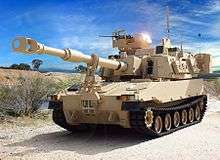
The newest M109 version for U.S. service is the M109A7, formerly known as the M109A6 Paladin Integrated Management (PIM). The M109A7 shares common components with the Bradley Fighting Vehicle such as the engine, transmission, and tracks. This creates commonality with other systems and maximizes cost-savings in production, parts inventory, and maintenance personnel. The M109A7's on-board power systems harness technologies originally developed for the Non-Line-of-Sight Cannon; the electric drive is faster than the previous hydraulic system, and the automatic rammer more consistently rams the round into the gun for consistent velocities and better accuracy. It features a 600-volt on-board power system to accommodate additional armor and future networking technologies as they become ready. The M109A7 can sustain a one-round per-minute rate of fire and a maximum rate of fire of four rounds per-minute.[15]
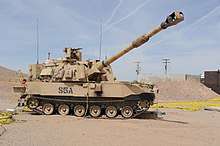
Weighing 78,000 lb (35,000 kg), the M109A7 is 10,000 lb (4,500 kg) heavier than its predecessor, and it has the capacity to grow to 110,000 lb (50,000 kg). Even with the weight increase, the M109A7 can travel faster than previous versions at 38 mph (61 km/h) and is more maneuverable than a Bradley Fighting Vehicle.[16]
Prototypes of the vehicle underwent government testing in preparation for a low-rate initial production decision. The testing included reliability, availability, and maintainability mission testing as well as ballistic hull and turret testing. M109A7 was slated to begin low-rate initial production by 2013. The U.S. Army planned on procuring a fleet of 580 sets of M109A7 howitzers and M992A3 ammunition support vehicles.[15]
In October 2013, the Defense Acquisition Board approved the decision to start M109A7 production. The FY 2014 budget called for $340.8 million in Paladin funding, which would be two dozen vehicle sets at $14.4 million per vehicle. The Army plans to buy 133 vehicles in 66 one-half vehicle sets starting in 2014, although one M109A7 howitzer and two supporting M992A3 ammunition carriers will be destroyed during tests. A full-rate production decision planned for February 2017.[17][18] On 31 October 2013, BAE received a $668 million contract to begin low-rate initial production of the M109A7.[19] The first M109A6 and M992A2 vehicles were disassembled and reassembled to M109A7 and M992A3 standard as part of low-rate initial production beginning in summer 2014.[20] Low-rate production deliveries began in April 2015.[21] The contract for full rate production was signed in December 2017 with 48 vehicles slated for construction.[22] The Army plans to upgrade 689 Paladins to A7-standard.[23]
The Army is looking to increase the capabilities of the M109A7. By introducing the new XM1113 rocket-assisted projectile (RAP),[24] it can reach 40 km (25 mi) from the current 39-caliber barrel, and a planned barrel extension to 58-caliber can increase its range to 70 km (43 mi). An additional XM1113 improvement over the legacy RAP round is the replacement of the high explosive, TNT, with an insensitive munition that is less volatile and less prone to unplanned detonation.[25] The Army is also working on an autoloader to increase sustained rate of fire to 6–10 rounds per minute. These improvements are being developed under the Extended Range Cannon Artillery (ERCA) program, with the upgraded system designated the M1299.[24] The first ERCA cannons are planned to be fielded in 2023, with the autoloader fielding one year later.[26] Another part of the ERCA effort is the use of a new super-charged propellant to fire the shells, which required redesigning the howitzer to handle higher pressures.[27]
Derivatives
M992
The Field Artillery Ammunition Supply Vehicle (FAASV) is built on the chassis of the M109-series. It is also colloquially referred to as a "CAT" (referring to its nomenclature, CAT: Carrier, Ammunition, Tracked). It replaces the M548 supply vehicle. Unlike the M548, it is armored. This ammunition vehicle has no turret, but has a taller superstructure to store 93 rounds and an equivalent number of powders and primers. There is a maximum of 90 conventional rounds, 45 each in two racks, and 3 M712 Copperhead rounds. Until recently, much of the remaining internal crew space was taken up by a hydraulically powered conveyor system designed to allow the quick uploading of rounds or transfer of rounds to the M109-series howitzer. Most early models had an additional mechanism called an X-Y Conveyor to lift the rounds into the honeycomb-like storage racks in the front of the superstructure. A ceiling plate above the two racks can be unbolted and opened to allow the racks to be winched out of the vehicle. This vehicle is fitted with a Halon fire suppression system and a weapons mount similar to that on the M109 turret, usually mounting a Mk 19 grenade launcher for local defense against infantry and light armored vehicles. The latest models have a mounting point for two secure radios.
The hydraulic conveyor system is removed by crews as it is slower than moving the rounds by hand. Recently the army has removed the conveyor system and changed the two horizontal opening doors to two vertical doors opening from the center to provide protection to the crew during transfers.
The vehicle also contains a 2-stroke diesel powered auxiliary power unit that can power all non-automotive energy requirements on the Field Artillery Ammunition Supply Vehicle and on the howitzer when a slave cable is used to connect the two. This reduces fuel consumption when mobility is not required.
Training systems
The US Army uses the Fire Support Combined Arms Tactical Trainer (FSCATT) in two versions for initial and sustainment training of the M109A6 and M109A5.[28] The system uses an actual surplus turret and a simulated ammunition system.
The Swiss Army uses a highly advanced KAWEST trainer from Van Halteren Metaal of the Netherlands.
The Dutch, Belgian, Thai, and Israeli Armies have various configurations of the Van Halteren Metaal M109 Howitzer Crew Trainer (HCT).
The US Army PEO STRI has a program called M109A7 Howitzer Crew Trainer (HCT). The plan is to procure 16 systems beginning in the 3rd Quarter of FY 20.[29]
Operators

Current operators
M109
M109A1
M109A2/A3
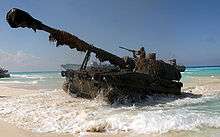













M109A2/A5



M109A5
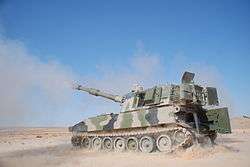













M109A7

K55/K55A1

Former operators
M109A2/A3
.svg.png)




M109A4
.svg.png)
.svg.png)
See also
- 2S3 Akatsiya - Soviet/Russian equivalent
- 2S19 Msta - Soviet/Russian equivalent
- PzH 2000 - German equivalent
- GCT 155mm - French equivalent
- AS-90 - British equivalent
- K9 Thunder - South Korean howitzer developed by Samsung Techwin
- Palmaria (artillery) Italian equivalent built for export
- PLZ-05 – Chinese equivalent
- Type 75/Type 99 – Japanese equivalent
- Sholef
- Bandkanon 1 – armored self-propelled L/50 155 mm gun for the Swedish Army from 1967 to 2003
- M107 projectile
- List of artillery
- List of land vehicles of the U.S. Armed Forces
- M549
- M864
- M795
Notes
- "Battle of Mosul 2016– French Artillery Fire on ISIS / M109 Paladins Fire Support". YouTube.
- "Paladin 155mm Self-Propelled Howitzer". Army Technology. Archived from the original on 22 December 2010. Retrieved 23 December 2010.
- Jeff Quitney (14 March 2012). "M109 155mm Howitzer Self-Propelled from "Weapons of the Field Artillery" 1965 US Army" – via YouTube.
- These Are the New Weapons the Pentagon Chief Wants for Tomorrow’s Wars Archived 3 February 2016 at the Wayback Machine – Defenseone.com, 2 February 2016
- 'Micro' Drones, 'Arsenal' Plane, Railguns Funded in New Defense Budget Archived 8 October 2016 at the Wayback Machine – Military.com, 2 February 2016
- Robot Boats, Smart Guns & Super B-52s: Carter’s Strategic Capabilities Office Archived 9 February 2016 at the Wayback Machine – Breakingdefense.com, 5 February 2016
- Lathrop, R. (5 February 2005). M109 155mm Self-Propelled Howitzer 1960–2005. Osprey Publishing. p. 15. ISBN 9781841766317.
- "M109 155mm SP Howitzer". Archived from the original on 7 May 2016. Retrieved 9 May 2016.
- "M109". ruag.com. Archived from the original on 9 July 2018. Retrieved 9 May 2018.
- "Chile Requests a Mechanized Artillery Battalion". Defense Industry Daily. 6 October 2011. Archived from the original on 9 May 2018. Retrieved 9 May 2018.
- Christian E Bergheim (21 November 2006). "Gammelt skyts treffer blink". Forsvarets Forum (in Norwegian). Archived from the original on 6 January 2017. Retrieved 6 February 2017.CS1 maint: BOT: original-url status unknown (link)
- "K56". Archived from the original on 11 October 2011. Retrieved 27 October 2011.
- 군사세계. "유용원군사세계 - bemil.com". bemil.chosun.com. Archived from the original on 5 April 2015. Retrieved 27 October 2011.
- "Fire Control System For K55A1".
- "Army developing new self-propelled howitzer". 1 September 2011. Archived from the original on 11 October 2012. Retrieved 5 September 2011.
- US Army Breaking Out the Big New Guns – Defensenews.com, 27 April 2014
- BAE Systems could obtain new contract from U.S. Army for M109A7 155m self-propelled howitzer Archived 29 October 2013 at the Wayback Machine – Armyrecognition.com, 26 October 2013
- New Paladin to Enter Low-Rate Production – Defensenews.com, 21 October 2013
- BAE Systems Awarded Contract to Begin Production of Paladin Integrated Management Archived 2 November 2013 at the Wayback Machine – BAE press release, 31 October 2013
- Self-propelled howitzer M109A7 and M992A3 carrier ammunition enter in service with U.S. Army Archived 16 July 2015 at the Wayback Machine – Armyrecognition.com, 20 May 2014
- Army accepts delivery of first M109A7 Self-Propelled Howitzer system Archived 10 April 2015 at the Wayback Machine – Army.mil, 9 April 2015
- "U.S. Army contracts for full-rate production on M109A7 weapon vehicle – Military Embedded Systems". mil-embedded.com. Archived from the original on 27 December 2017. Retrieved 28 December 2017.
- Plan would double artillery upgrades in Army arsenal over the next five years. Army Times. 22 March 2019.
- US Army to demo precision strike, hypersonics, ramjet capabilities in just a few years. Defense News. 20 March 2018.
- Malyasov, Dylan. "General Dynamics to unveil extended range projectile that uses rocket technology". Defense Blog - On line Military Magazine. Retrieved 18 February 2020.
- Army picks 6 to work on autoloader for extended-range cannon. Defense News. 24 January 2020.
- New Army Cannon Doubles Range; Ramjet Ammo May Be Next. Breaking Defense. 6 March 2020.
- "Fire Support Combined Arms Tactical Trainer (FS-CATT)". US Army. Archived from the original on 9 November 2011. Retrieved 10 December 2011.
- "Archived copy". Archived from the original on 22 January 2019. Retrieved 21 January 2019.CS1 maint: archived copy as title (link)
- "Panzerhaubitze M 109 KAWEST". He.admin.ch. 18 December 2009. Archived from the original on 11 May 2011. Retrieved 23 December 2010.
- "RUAG Land Systems 155 mm M109 upgrade (Switzerland)".
- Stort set intet fungerende dansk artilleri tilbage Ingeniøren, October 2015. Quote: "Of the 6 operative, are only 2–4 available"
- "DefenceNet – "Κοσμογονία" για το πυροβολικό του ΕΣ: Αγοράζονται 36 PzH-2000 και 169 μεταχειρισμένα Μ109Α3GEA2" (in Greek). Defencenet.gr. 13 May 2009. Archived from the original on 12 May 2011. Retrieved 23 December 2010.
- Mehta, Admiral Sureesh (2008). South Asia Defence And Strategic Year Book 2008. Pentagon Press. p. 329. ISBN 978-81-8274-320-5.
- "Cold War Bargains Still To Be Had". strategypage.com. 22 February 2010. Archived from the original on 29 October 2013. Retrieved 6 May 2013.
- "M-109 A2/A3 – FMC-United Defense / BAE Systems / Portugal". Área militar. Archived from the original on 30 September 2009. Retrieved 8 May 2011.
- "Obus Autopropulsado ATP M-109 A2 – InfanterÃa de Marina – Armada Española" (in Spanish). Armada.mde.es. Archived from the original on 26 April 2011. Retrieved 23 December 2010.
- "Министр обороны подписал договор о покупке б/у гаубиц у Австрии". Rus.TVNET (in Russian). 27 May 2017. Retrieved 30 May 2017.
- "VIDEO: Bruņotie spēki sāk apgūt jaunās haubices (VIDEO: The Armed Forces start to master the new howitzers". LSM.lv (in Latvian). 9 October 2017. Archived from the original on 16 March 2018. Retrieved 15 March 2018.
- "Regimento Mallet recebe M109 A5 + BR". Forte (in Portuguese). 15 October 2019.
- Brazil; Army plans to purchase US Army surplus 155mm artillery pieces Archived 5 December 2014 at the Wayback Machine – Dmilt.com, 13 March 2013
- Wasserbly, Daniel (20 September 2016). "BAE Systems awarded long-stalled Brazilian howitzer modernisation deal". IHS Jane's 360. Washington, DC. Retrieved 20 September 2016.
- Barreira, Victor (18 July 2017). "Brazilian Army receiving 60 more US M109A5 howitzers". IHS Jane's 360. Archived from the original on 18 July 2017. Retrieved 18 July 2017.
- "Error Page". BAE Systems – International. Archived from the original on 7 October 2011. Retrieved 5 October 2011.
- "U.S. delivers 48 field artillery cannons to Pakistan Army". News.xinhuanet.com. 14 February 2010. Archived from the original on 6 November 2012. Retrieved 19 March 2013.
- "M-109 A5 – FMC-United Defense / BAE Systems / Portugal". Archived from the original on 30 September 2009. Retrieved 8 May 2011.
- "Ejército de tierra – ATP 155/39 M-109 A5E" (in Spanish). Ejercito.mde.es. 1 December 2001. Archived from the original on 12 November 2010. Retrieved 23 December 2010.
- Binnie, Jeremy (24 November 2016). "Morocco takes delivery of M109A5 howitzers". IHS Jane's 360. Retrieved 28 November 2016.
- "The Kingdom of Saudi Arabia – 155mm M109A6 Paladin Medium Self-Propelled Howitzer System". Defense Security Cooperation Agency. 5 April 2018. Archived from the original on 7 April 2018. Retrieved 7 April 2018.
- Judson, Jen (21 December 2017). "US Army awards BAE contract to build full-rate production howitzers".
- "Oto Melara 155 mm M109L self-propelled howitzer (Italy)". Jane's Armour and Artillery. Janes.com. 9 February 2010. Archived from the original on 12 December 2009. Retrieved 23 December 2010.
- "The Canadian Army – 2006 – Structure – Fact Sheet – Transformation". Archived from the original on 7 June 2008.
- R. Lathrop; Steven J. Zaloga (2005). M109 155mm Self-Propelled Howitzer 1960–2005. Bloomsbury USA. p. 48. ISBN 978-1-84176-631-7.
External links
| Wikimedia Commons has media related to M109 howitzer. |
